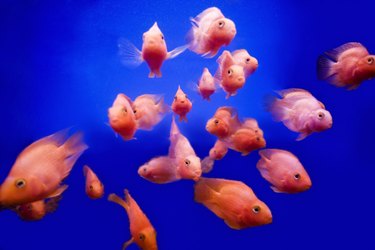
You won't find a school of fish at your local buffet, but if fish could talk, they might tell you they're finicky diners who prefer a more exciting diet than floating flakes. Commercial food retailers provide options, but DIY fish food recipes prepared in your own kitchen can provide a variety of cuisine for your finned friends.
The Right Balance
Video of the Day
Before you set out to gather ingredients for your DIY fish food, it's important to understand what kind of fish you're feeding. Fish are categorized as either herbivores, carnivores or omnivores. Check with your local aquarist or fish supply retailer to determine what type of fish you're feeding. Herbivores require a homemade food with a makeup of 1 part meat to 1 1/2 parts vegetables. Carnivores require 3 parts meat to 1 part vegetables and omnivores require 2 parts meat to 1 part vegetables.
Video of the Day
Gel Foods
The most common homemade fish food is gel food with a gelatin base and vegetable and meat additives. The mixture is easy to prepare and easy to store. Fish flake food is best left to the professionals, as even with a food dehydrator it's difficult to get the content and flake just right.
The Right Ingredients
Regardless of whether your fish is an omnivore, an herbivore or a carnivore, they all require some meat in their DIY food. Consider shrimp, cod, salmon, clams or tuna as a meat additive in your gel food. You also can improvise with beef heart, with the fat removed, or traditional foods such as bloodworms, which can be a little harsh on the budget. Veggie choices include peas, spinach, zucchini, carrots or red leaf lettuce, which is easy for fish to digest. Baby food also can be substituted for vegetables, and won't need as much time in the blender.
From Counter to Aquarium
Once you've assembled your vegetables and meats, add them to your blender giving consideration to your meat/vegetables ratio depending upon the dietary requirements of your particular fish. Blend this mixture until it has a mushy consistency. In a separate pan, add one packet of unsweetened gelatin to the proper amount of water based on the prep directions on the packet. Cook as directed. Slowly add your blender mixture, pour into ice cube trays and place in the refrigerator to cool. Once the mixture is set, cut the cubes in half, place in freezer bags and store in the freezer for later use.